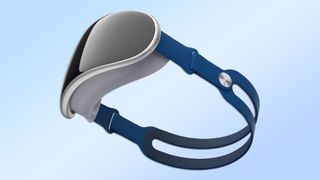
Update: Apple's AR headset could be powered by 'realityOS.'
While Apple's AR/VR headset remains a mystery, a new report has emerged that could shed some light on its advanced display tech as well as its potential launch window.
According to analyst Ming-Chi Kuo, as reported by MacRumors, Apple is looking to ship the rumored headset at the end of 2022, with shipments ramping up in the first quarter of 2023.
MacRumors stumbled upon this intel after acquiring a research note from TF International Securities. In it, the report stated that the headset would use "3P pancake lenses," which, according to the site, "have a folded design that allows light to reflect back and forth between the display and lenses." This, according to MacRumors, will allow for a compact and lightweight headset.
In the world of photography, pancake lenses refer to flat, thin prime lenses that can't zoom due to its compact size. These lenses tend to have a wider angle as well.
This is not the only recent rumor to emerge regarding Apple's VR ambitions. According to a report by Display Supply Chain Consultants (DSCC), as detailed by 9to5Mac, Apple's upcoming headset may feature three displays: two Micro OLEDs and one AMOLED panel.
Sony is apparently the manufacturer on deck to make the 4K 4000 x 4000 Micro OLED panels with a 1.4-inch diagonal. This absolutely destroys the current king of VR resolution, the HTC Vive Pro 2. As for the AMOLED screen, a supplier was not mentioned, but DSCC did say it would be a low-resolution screen for "peripheral vision, thereby enabling a foveated display system."
Sign up to get the BEST of Tom’s Guide direct to your inbox.
Upgrade your life with a daily dose of the biggest tech news, lifestyle hacks and our curated analysis. Be the first to know about cutting-edge gadgets and the hottest deals.
Foveated displays refer to the fovea of a person's eye. The fovea sits at the back of the eye, along the retina. The fovea helps with sharp central vision. A foveated display essentially adjusts the resolution to areas a person's eye is focusing on. So, for example, if a person is focusing on a person in a crowd, the display would enhance the resolution of that particular focus point and lower the resolution of the periphery. This video by YouTube channel SweViver does an excellent job explaining fixed foveated rendering, or FFR.
If true, this suggests that Apple could be implementing eye-tracking tech, which may be similar to what Sony confirmed with its PSVR 2 at CES 2022. Although, Apple will not be the first company to do this. The Varjo V3 is a foveated headset that's currently on the market.
Like Kuo, DSCC also believes that Apple will release its headset at the end of 2022. And like a previous Bloomberg report, DSCC reports that it would cost "several thousand dollars." Unlike the Oculus Quest 2, it seems that Apple is targeting professionals and developers, at least at first.
According to DSCC, Apple's headset will also have multiple cameras for hand tracking, as well as a possible LiDAR sensor. To power two Sony-made 4000 x 4000 displays, DSCC believes Apple will throw in a high-end CPU and GPU, which makes sense to us.
As to whether Apple's VR/AR headset lands on our best VR headsets list remains to be seen.
Imad is currently Senior Google and Internet Culture reporter for CNET, but until recently was News Editor at Tom's Guide. Hailing from Texas, Imad started his journalism career in 2013 and has amassed bylines with the New York Times, the Washington Post, ESPN, Wired and Men's Health Magazine, among others. Outside of work, you can find him sitting blankly in front of a Word document trying desperately to write the first pages of a new book.

